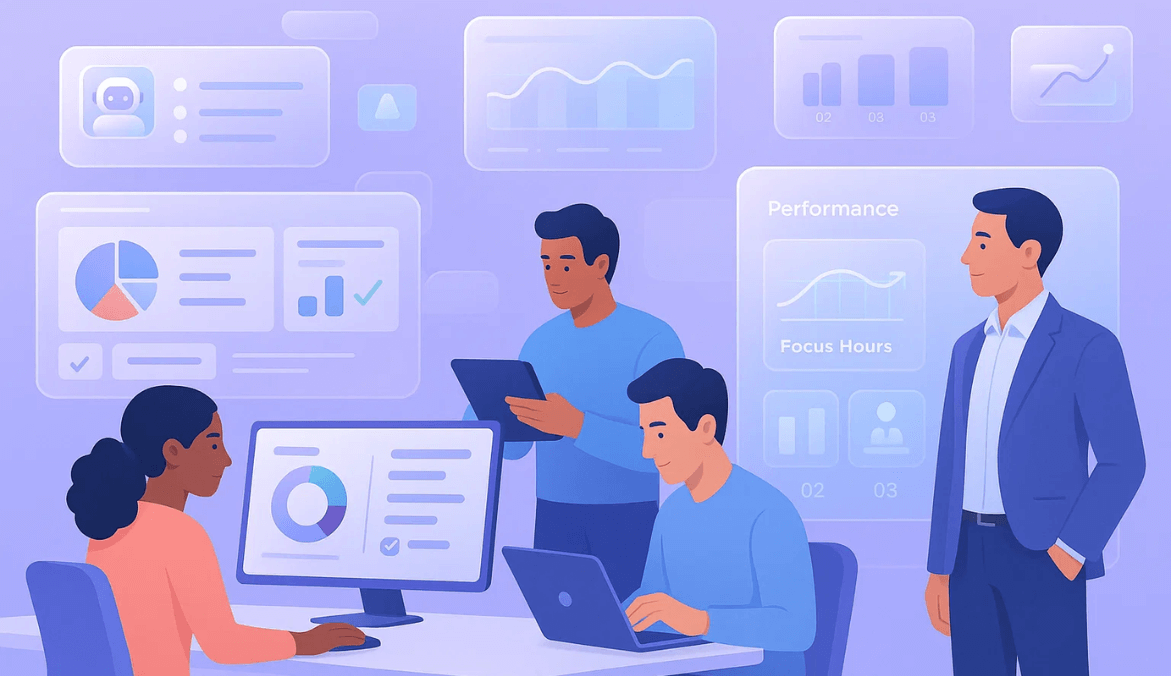Introduction
Workforce optimization isn’t just about doing more with less — it’s about creating balance: the right people, in the right roles, doing work that actually matters. It works even better when supported by strong strategic workforce planning, ensuring teams have the skills and capacity the future demands.
In this guide, we’ll cover what workforce optimization really means in 2025, why it’s so critical, and nine strategies that can transform how your team performs — from AI-powered forecasting to dynamic scheduling, coaching loops, and more.
If you lead teams, manage operations, or simply want to improve performance without burning people out — this one’s for you.
With over 10+ years of experience leading productivity and workforce transformation initiatives across industries, I’ve seen how optimization truly changes team culture when done with empathy and clarity.
What Is Workforce Optimization (and How It’s Different from Workforce Management)?
Workforce Optimization (WFO) is the process of aligning people, processes, and technology to achieve peak performance with minimal friction.
It goes beyond Workforce Management (WFM), which focuses on scheduling and attendance. WFO takes a more holistic view — bringing together analytics, coaching, quality assurance, and engagement to create sustainable productivity.
Think of WFM as “who works when,” and WFO as “how well we’re working and why.”
In 2025, this conversation is also shifting toward AI-led optimization — where forecasting, scheduling, and feedback loops happen in real time.
From 10+ years in operations: I’ve seen that workforce optimization isn’t about squeezing more output — it’s about aligning energy with purpose. When people understand why they’re scheduled the way they are, resistance drops and performance naturally rises.
Why Workforce Optimization Matters More Than Ever
Let’s be honest — 2025 is a wild mix of hybrid schedules, multiple tools, and constant context-switching.
Workforce optimization gives leaders control without micromanagement. When done right, it leads to:
- Higher efficiency: fewer idle hours, better utilization.
- Lower costs: smarter scheduling reduces overtime and overstaffing.
- Better engagement: employees feel seen and supported.
- Improved customer outcomes: faster response times, fewer escalations.
Did you know?
The Workforce Optimization Strategies You Need
Here’s where theory meets practice. Below are nine proven strategies that top-performing teams are using right now.
1. Data-Driven Demand Forecasting & Capacity Planning
The era of guessing is over. Use historical data, seasonality, and AI-based forecasting tools to plan staffing precisely.
For instance, many contact centres now predict not just when demand spikes, but which types of issues are likely to come up — enabling better skill allocation.
From the field: At one client I worked with, switching from static to AI-based forecasting improved schedule accuracy by 22% in the first quarter. The magic wasn’t the algorithm — it was the discipline of weekly reviews and acting on small insights fast.
Action step: Start with a 3-month rolling forecast model. Review it biweekly. Small corrections early prevent large-scale firefighting later.
2. Skills Mapping & Dynamic Scheduling
Your people are your biggest optimization lever — not your tools.
Create a skills matrix that maps employees’ strengths and certifications, then use it to automate fair and efficient scheduling.
Personal example: We once discovered a junior analyst who loved automation projects outside work. She became our go-to QA automation lead within months — saving us both time and hiring costs. A simple skills inventory can uncover hidden strengths across your team.
Action step: Update your skill maps quarterly. Use them to rotate staff into roles that stretch their potential but align with team goals.
3. Quality & Coaching Loops That Actually Work
Many teams track performance metrics but forget the feedback loop.
True optimization comes when data leads to better behaviour — through coaching, not punishment.
Set up a structured QA program: record real interactions, review 10% of them weekly, and discuss improvement ideas one-on-one.
Action step: Treat quality reviews as conversations, not scorecards. Recognize trends, not just errors.
4. AI-Assisted Workflows & Digital Workers
AI is quietly becoming a co-worker — summarizing tickets, flagging anomalies, even suggesting shift swaps.
Don’t fear it. Train your team to use AI tools as accelerators, not replacements.
Action step: Pilot AI tools on repetitive admin tasks first (like timesheet approvals or daily summaries) — then expand gradually.
5. Onboarding to Excellence: The 90-Day Coaching Playbook
Optimization starts on Day 1. Create a 30-60-90 day playbook for every new hire — blending training, mentoring, and measurable milestones.
Action step: Tie every new hire’s goals to a key metric — whether it’s turnaround time, quality score, or engagement. Review progress weekly, not quarterly.
6. Real-Time Performance Dashboards
Dashboards turn raw data into decisions. Use live performance dashboards that display KPIs like utilization, response time, or adherence. Let everyone see the same truth — transparency builds accountability.
Action step: Display top 5 metrics team-wide. Keep the focus on progress, not policing.
7. Engagement by Design
Engagement isn’t about birthday posts or gift cards — it’s about inclusion.
Allow employees to set shift preferences, recognize wins publicly, and connect efforts to company goals.
Action step: Add a 5-minute “voice of the team” round in your weekly stand-up. Let employees suggest one process improvement per month.
8. Compliance-First Scheduling
As remote work spreads, labour laws around breaks, overtime, and privacy are tightening. Build compliance into your optimization model — don’t treat it as an afterthought.
Action step: Document all schedule rules in your WFO software. It protects both your company and your people.
9. Automate Low-Value Work
Automation isn’t about replacing humans — it’s about giving them time back.
Automate routine approvals, reminders, and status updates so employees focus on tasks that require judgment and creativity.
How To Implement Workforce Optimization in 90 Days
Here’s a simple 3-phase approach that works whether you’re a 30-person team or a 3000-person enterprise.
Phase 1: Baseline (Weeks 1–3)
- Audit data, identify performance gaps, and set 3 core KPIs (e.g., utilization, quality, engagement).
- Interview team leads about pain points.
Phase 2: Pilot (Weeks 4–8)
- Select one department or team.
- Introduce forecasting + scheduling improvements.
- Run weekly check-ins and compare pre/post metrics.
Phase 3: Scale & Standardize (Weeks 9–13)
- Roll out dashboards org-wide.
- Build a RACI matrix for accountability.
- Create monthly “optimization reviews” — short, focused syncs.
Hard-earned truth: The biggest wins don’t come from tools — they come from conversations. When people see data as a mirror, not a microscope, adoption happens naturally.
KPIs and Benchmarks That Matter
Here are some key metrics to measure success:
| KPI | Formula | Good Benchmark |
|---|---|---|
| Forecast Accuracy | (Actual / Forecast) × 100 | 90–95% |
| Schedule Adherence | Time scheduled vs worked | 85–90% |
| Utilization | Productive hrs / Paid hrs | 75–85% |
| Attrition | Departures / Total staff | <10% quarterly |
| Employee NPS | % Promoters – % Detractors | +40 or higher |
Action step: Track 3 core KPIs weekly and share results transparently with your team. Accountability builds culture.
Industry Playbooks: How Optimization Looks in Different Worlds
- Contact Centres: Focus on QA, speech analytics, and real-time rebalancing.
- Field Service: Optimize routes + skills matching.
- Retail & Hospitality: Use traffic-based staffing and flexible scheduling.
- SaaS & Engineering: Prioritize flow efficiency and WIP limits.
- Professional Services: Track billable vs non-billable ratios.
Governance, Policy & Ethics
Optimization isn’t a free pass for surveillance.
Create clear policies around data use, monitoring transparency, and AI explainability.
When employees know what’s tracked and why, they stay engaged and compliant.
Common Pitfalls to Avoid
- Buying tools before fixing processes
- Tracking too many metrics
- Ignoring change management
- Automating the wrong tasks
- Forgetting to celebrate small wins
Closing Thoughts
Workforce optimization isn’t about control — it’s about clarity.
The more visible work becomes, the less you need to push productivity — it starts to happen on its own.
From experience: Optimization isn’t about making people work harder — it’s about removing the noise that keeps them from doing their best work.”
If you’re looking to take your team from busy to truly effective this year — start small, measure relentlessly, and never forget that optimization is a people story first, a process story second.
FAQs
AI-based forecasting, skill mapping, coaching loops, and real-time dashboards lead the list.
WFM is about scheduling; WFO adds performance, engagement, and quality dimensions.
Run a 90-day pilot — start small, measure hard, scale fast.
Absolutely. Even 10-person teams benefit from clarity, structure, and smarter scheduling.
 Gift Card ₹999
Gift Card ₹999

